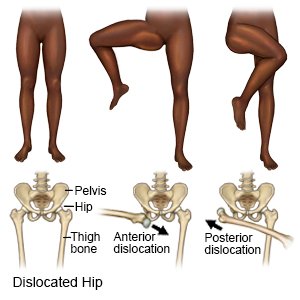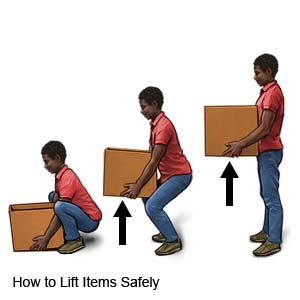Hip Dislocation
Medically reviewed by Drugs.com. Last updated on Aug 4, 2025.
A hip dislocation occurs when your thigh bone is forced out of your hip socket.
 |
DISCHARGE INSTRUCTIONS:
Seek care immediately if:
- You have severe pain.
- You dislocate your hip again.
Call your doctor if:
- You have a fever.
- You have pain that does not go away after you take pain medicine.
- You cannot walk well with your cane or crutches.
- You have questions or concerns about your condition or care.
Medicines:
You may need the following:
- Prescription pain medicine may be given. Ask your healthcare provider how to take this medicine safely. Some prescription pain medicines contain acetaminophen. Do not take other medicines that contain acetaminophen without talking to your healthcare provider. Too much acetaminophen may cause liver damage. Prescription pain medicine may cause constipation. Ask your healthcare provider how to prevent or treat constipation.
- Take your medicine as directed. Contact your healthcare provider if you think your medicine is not helping or if you have side effects. Tell your provider if you are allergic to any medicine. Keep a list of the medicines, vitamins, and herbs you take. Include the amounts, and when and why you take them. Bring the list or the pill bottles to follow-up visits. Carry your medicine list with you in case of an emergency.
Manage a hip dislocation:
It will take 2 to 3 months for your hip to heal.
- Use a walker or crutches as directed. Ask your healthcare provider or orthopedist when you can put weight on your injured side. As your hip heals, use a cane to help you walk until your limp goes away.
- Avoid high-impact activities and sports. Do this for 6 to 12 weeks or until your hip strength has returned.
- Go to physical therapy, if directed. A physical therapist teaches you exercises to increase the range of motion in your hip. Exercises also make your hip stronger and decrease pain.
Prevent another hip dislocation:
Follow these precautions for 6 weeks after your injury or as directed:
- Sit with your back straight and your feet flat on the floor. Do not cross your legs. Do not lean forward when you sit in a chair.
- Keep your knees apart. Place a pillow or wedge between your knees when you sit or lie. Do not twist your knees. Do not lift your knees higher than your hips.
- Do not sit in a low chair. Use armrests and your upper body strength to push yourself up from a sitting position.
- Do not bend at the waist to pick up an object from the floor. Bend your knees to reach the object, or use a tool to pick it up.

Follow up with your doctor or orthopedist as directed:
You may need another x-ray or CT scan. Write down your questions so you remember to ask them during your visits.
© Copyright Merative 2025 Information is for End User's use only and may not be sold, redistributed or otherwise used for commercial purposes.
The above information is an educational aid only. It is not intended as medical advice for individual conditions or treatments. Talk to your doctor, nurse or pharmacist before following any medical regimen to see if it is safe and effective for you.
Learn more about Hip Dislocation
Care guides
Further information
Always consult your healthcare provider to ensure the information displayed on this page applies to your personal circumstances.
